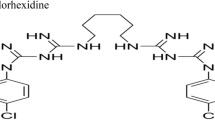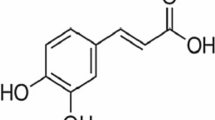Abstract
Laser flash photolysis and sodium dodecyl sulfate-polyacrylamide gel electrophoresis (SDS-PAGE) experiments were carried out to study the photosensitive damage induced by pazufloxacin (PAX) and the protection of lysozyme (Lyso) by ferulic acid (FCA), an active antioxidant. Transient absorption spectra revealed electron transfer from Lyso and FCA to 3PAX*, with respective bimolecular reaction rate constants of 6.3×107 and 1.4×1010 dm3/(mol s). A pulse radiolysis study was also performed to investigate the formation of Lyso radical cations. Results showed that FCA effectively inhibits the cross-linking of protein induced by fluoroquinolones. Finally, a mechanism of the protective effect of FCA on Lyso was proposed.
Similar content being viewed by others
References
Albini A, Monti S. Photophysics and photochemistry of fluoroquinolones. Chem Soc Rev, 2003, 32: 238–250
Barry AL, Fuchs PC. Antistaphylococcal activity of the fluoroquinolones Ci-960, Pd-131628, sparfloxacin, ofloxacin and ciprofloxacin. Eur J Clin Microbiol, 1991, 10: 168–171
Chu DTW, Fernandes PB. Structure-activity-relationships of the fluoroquinolones. Antimicrob Agents Ch, 1989, 33: 131–135
Domagala JM, Hanna LD, Heifetz CL, Hutt MP, Mich TF, Sanchez JP, Solomon M. New structure-activity-relationships of the quinolone antibacterials using the target enzyme: the development and application of a DNA gyrase assay. J Med Chem, 1986, 29: 394–404
Zhao B, Chignell CF, Rammal M, Smith F, Hamilton MG, Andley UP, Roberts JE. Detection and prevention of ocular phototoxicity of ciprofloxacin and other fluoroquinolone antibiotics dagger. Photochem Photobiol, 2010, 86: 798–805
Tolland J, Davies J, Elborn S, McKenna KE. Ciprofloxacin-induced phototoxicity: in vivo and in vivo data. Brit J Dermatol, 2008, 159: 129–130
Lipsky BA, Baker CA. Fluoroquinolone toxicity profiles: a review focusing on newer agents. Clin Infect Dis, 1999, 28: 352–364
Stahlmann R, Lode H. Toxicity of quinolones. Drugs, 1999, 58: 37–42
Condorelli G, De Guidi G, Giuffrida S, Sortino S, Chillemi R, Sciuto S. Molecular mechanisms of photosensitization induced by drugs XII. Photochemistry and photosensitization of rufloxacin: an unusual photodegradation path for the antibacterials containing a fluoroquinolone-like chromophore. Photochem Photobiol, 1999, 70: 280–286
Zhang P, Yao SD, Li HX, Song XY, Liu YC, Wang WF. Pulse radiolysis study on several fluoroquinolones. Radiat Phys Chem, 2011, 80: 548–553
Liu YC, Li HX, Cui RR, Tang RZ, Xu YL, Wang WF. Pulse radiolysis of sparfloxacin in neutral aqueous solution. Nucl Sci Tech, 2013, 24: S010311
Xu YL, Liu YC, Li HX, Zhang P, Tang RZ, Cao XY, Wang WF. Pulse radiolysis and laser flash photolysis study of balofloxacin. Nucl Sci Tech, 2013, 24: S010312
Li HX, Zhang P, Liu YC, Tang RZ, Xing ZG, Yao SD, Fu HY, Wang WF. Photophysical properties of gatifloxacin in aqueous solution by laser flash photolysis and pulse radiolysis. Radiat Phys Chem, 2012, 81: 40–45
Ferguson J, Dawe R. Phototoxicity in quinolones: comparison of ciprofloxacin and grepafloxacin. J Antimicrob Chemoth, 1997, 40: 93–98
Man I, Traynor NJ, Ferguson J. Recent developments in fluoroquinolone phototoxicity. Photodermatol Photo, 1999, 15: 32–33
Gurbay A, Gonthier B, Signorini-Allibe N, Barret L, Favier A, Hincal F. Ciprofloxacin-induced DNA damage in primary culture of rat astrocytes and protection by vitamin E. Neurotoxicology, 2006, 27: 6–10
Lhiaubet-Vallet V, Bosca F, Miranda MA. Photosensitized DNA damage: the case of fluoroquinolones. Photochem Photobiol, 2009, 85: 861–868
Dall’Acqua F, Viola G, Vedaldi D, Aloisi GG, Elisei F, Latterini L, Passeri R. Photoinduced modifications by fluoroquinolone drugs in bovine serum albumin (BSA) and ribonuclease A (RNAse) as model proteins. Arkivoc, 2007: 231–244
Liu L, L KX, Li Y, Feng YF, Yin Q, Sun CH. HPLC studies on determination of pazufloxacin in human plasma. Chin J Pharm Anal, 2004, 24: 529–531
Zhang ZL, Li JJ, Qu LB, Yang R. determination of pazufloxacin mesylas by capillary electrophoresis with electrochemiluminescence detection. Chinese J Anal Chem, 2008, 36: 941–946
Yang XY, You XP. Pharmacological research and clinical study of pazufloxacin mesilate silate. World Motes Abtibiot, 2003: 24–80
Rubinstein E. History of quinolones and their side effects. Chemotherapy, 2001, 47: 3–8
Nomura N, Mitsuyama J, Furuta Y, Yamada H, Nakata M, Fukuda T, Yamada H, Takahata M, Minami S. In vitro and in vivo antibacterial activities of pazufloxacin mesilate, a new injectable quinolone. Jpn J Antibiot, 2002, 55: 412–439
Liu YC, Zhang P, Li HX, Tang RZ, Cui RR, Wang WF. Photochemical properties and phototoxicity of pazufloxacin: a stable and transient study. J Photochem Photobiol B, 2013, 118: 58–65
Zhang ZX, Zhao HW, Zhu HP, Ge M, Wang WF, Yao SD, Li WX. SDS-PAGE study on photooxidation damage of lysozyme induced by riboflavin. Sci China Ser B, 2007, 50: 84–90
Temple NJ. Antioxidants and disease: more questions than answers. Nutr Res, 2000, 20: 449–459
Gilgun-Sherki Y, Melamed E, Offen D. Oxidative stress inducedneurodegenerative diseases: the need for antioxidants that penetrate the blood brain barrier. Neuropharmacology, 2001, 40: 959–975
Kanski J, Aksenova M, Stoyanova A, Butterfield DA. Ferulic acid antioxidant protection against hydroxyl and peroxyl radical oxidation in synaptosomal and neuronal cell culture systems in vitro: structureactivity studies. J Nutr Biochem, 2002, 13: 273–281
Twu YK, Shih IL, Yen YH, Ling YF, Shieh CJ. Optimization of lipase-catalyzed synthesis of octyl hydroxyphenylpropionate by response surface methodology. J Agr Food Chem, 2005, 53: 1012–1016
Saija A, Tomaino A, Trombetta D, De Pasquale A, Uccella N, Barbuzzi T, Paolino D, Bonina F. In vitro and in vivo evaluation of caffeic and ferulic acids as topical photoprotective agents. Int J Pharm, 2000, 199: 39–47
Maurya DK, Salvi VP, Nair CKK. Radiation protection of DNA by ferulic acid under in vitro and in vivo conditions. Mol Cell Biochem, 2005, 280: 209–217
Blake CCF, Koenig DF, Mair GA, North ACT, Phillips DC, Sarma VR. Structure of hen egg-white lysozyme: a 3-dimensional fourier synthesis at 2a resolution. Nature, 1965, 206: 757–61
Yao SD, Sheng SG, Cai JH, Zhang JS, Lin NY. Nanosecond pulseradiolysis studies in China. Radiat Phys Chem, 1995, 46: 105–109
Agrawal N, Ray RS, Farooq M, Pant AB, Hans RK. Photosensitizing potential of ciprofloxacin at ambient level of UV radiation. Photochem Photobiol, 2007, 83: 1226–1236
Carlucci G. Analysis of fluoroquinolones in biological fluids by high-performance liquid chromatography. J Chromatogr A, 1998, 812: 343–367
Liu YC, Zhang P, Li HX, Wang WF. Ciprofloxacin photosensitized oxidation of 2′-deoxyguanosine-5′-monophosphate in neutral aqueous solution. Photochem Photobiol, 2012, 88: 639–644
Li HX, Liu YC, Tang RZ, Zhang P, Fu HY, Yao SD, Wang WF. Pulse radiolysis study on gatifloxacin: a fluoroquinolone antibiotic. Sci China Chem, 2012, 55: 1358–1363
Lu CY, Lin WZ, Wang WF, Han ZH, Yao SD, Lin NY. Riboflavin (VB2) photosensitized oxidation of 2′-deoxyguanosine-5′-monophosphate (dGMP) in aqueous solution: a transient intermediates study. Phys Chem Chem Phys, 2000, 2: 329–334
Edwards AM, Silva E. Exposure of tryptophanyl residues in alphalactalbumin and lysozyme: quantitative-determination by fluorescence quenching studies. Radiat Environ Bioph, 1986, 25: 113–122
Davies KJA. Protein damage and degradation by oxygen radicals. 1. General-aspects. J Biol Chem, 1987, 262: 9895–9901
Author information
Authors and Affiliations
Corresponding author
Rights and permissions
About this article
Cite this article
Xu, Y., Liu, Y., Li, H. et al. Photosensitive damage of lysozyme caused by pazufloxacin and the protective effect of ferulic acid. Sci. China Chem. 58, 508–513 (2015). https://doi.org/10.1007/s11426-014-5174-z
Received:
Accepted:
Published:
Issue Date:
DOI: https://doi.org/10.1007/s11426-014-5174-z




